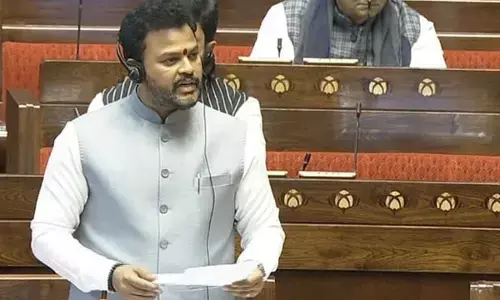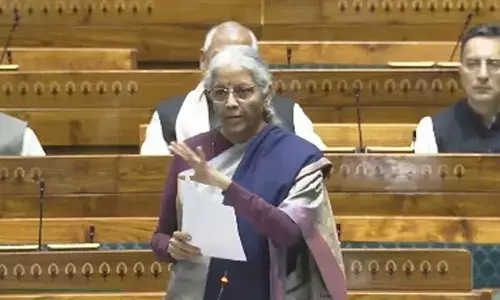Democrats, Republicans haven't learnt lessons

Gaps and lapses occur when Congress fails to approve funding for a government activity
Washington: US governments – Democrats or Republicans – are far from learning from the long history of threatened and real shutdowns, US media reports say. "American exceptionalism is real... One example is the government’s continuing inability to approve budgets on time. That’s the fuel of government shutdowns that don’t happen elsewhere like they happen here," says the Washington Post.
The US has seen as many as 21 shutdown possibilities in its 50 years of Congress and still hasn’t learnt to cope up with it, media reports assert. "... all shutdowns are partial. Some government services always continue. Yet the disruption from even a threatened shutdown, like we are experiencing now, is serious -- a lesson America can’t seem to learn no matter how many chances it’s had," an op-ed page article in the Washington Post says.
With the second in two years' time under President Joe Biden, another shutdown looming for Sunday. The government has notified all agencies receiving government funding to be on the alert for the closure of the treasury and for cash to flow into their coffers. There have been five government shutdowns since fiscal 1977, according to the Congressional Research Service (CRS).
The commentary on shutdowns said shutdown threats come much more frequently and make headlines for months. There were two partial closures in fiscal 1996 of 5 days and 21 days, a 16-day stoppage in 2014, and a barely noticed, two-day 2018 weekend event.
The longest shutdown was the most recent – 34 days from December 21, 2018, to January 25, 2019 – making those holidays much less happy, the report said.
That was Donald Trump's presidency asking for funds to build the Great Wall to keep Mexican immigrants out and was opposed by Democrats.
Shockingly, since 1977, there have been 20 funding gaps or lapses. In October 1984, one gap ended followed by another that began on the same day, which are counted as two by CRS, because of the timing of temporary funding measures.
Gaps and lapses occur when Congress fails to approve funding for a government activity. Not all gaps lead to shutdowns. And if the lapse is short, government-funded agencies may not have time to complete shutdown activities before the money flows again. Agencies also can postpone shutting down if funding appears imminent.
The disruption in the economy does not get any easier, despite being repeatedly subjected to threatened and real shutdowns. Even an imminent shutdown like the current one can be disorienting, as agencies must prepare to close, taking time away from their missions.
Citizens must plan for the uncertainties of life as one does not know how long services will remain disrupted. Federal contractors are often forced to conduct business in a confused business environment.
Feds when furloughed in a shutdown must figure out how to survive without pay until retroactive checks are issued at the end of a shutdown. In the US pay cheques are issued on a fortnightly basis and families run depending on this cash flow.
However, it’s imperative that funding gaps and shutdowns be avoided with Congress approving the vital 12 regular appropriations relating to defence spending, homeland security cash needs and other bills by September 30 each year. Legislators in the Congress fail that basic duty -- funding the government on time – most of the time, CNBC said in a report.
Since fiscal 1977, the 12 regular appropriations bills that need to be approved to fully fund the government have been cleared on time only four times, in fiscal years 1977, 1989, 1995 and 1997, according to the research service. Its report said the 20 funding gaps ranged from one day to 34 full days.
September 30 is the most sacrosanct day in the fiscal year as it ends that day and it’s the most popular day to start a shutdown for Congressmen because since fiscal 1977 the government’s budget, or fiscal, year began on October 1 of each calendar year. The best way to leverage your demands is to hold the government of the day to ransom.
“Today, we’re threatened with much of the government shutting because chaotic Republicans in the House have done more arguing among themselves than governing, leaving funding legislation in serious doubt. Some of them apparently think shutting federal agencies isn’t such a bad thing, anyway," the Washington Post said in a caustic comment.
If hard right congressional demands are not accepted and “a shutdown occurs, then so be it,” Rep. Ralph Norman (R-S.C.) told The Hill last month. “We should not fear a government shutdown,” Rep. Bob Good (R-Va.), said outside the Capitol Building in July. “Most of what we do up here is bad anyway.”
Millions of people however disagree with these Congressmen, especially those who would miss out on much-needed federal services -- including Head Start preschool programs, the Women, Infants and Children (WIC) nutrition project, new small business loans, clinical trials, and other scientific research. Other operations like postal delivery, law enforcement, and air traffic control and security would continue.
The first threatened shutdown happened in 1879, according to a National Park Service article. “Fearing ‘negro domination,'” after the Civil War, the Park Service said White southern Democrats thwarted approval of the government’s $45 million budget because they did not want money for federal marshals and the Army to protect Black voting rights. “At no time before had there been such a bold attempt to 'shut down’ the operations of the federal government by a denial of funding.”
But that era was far different from modern-day politics. “The modern Congressional budget process didn’t take hold until the 1970s,” Maya MacGuineas, president of the nongovernmental, bipartisan Committee for a Responsible Federal Budget, explained, "so today’s funding battles are not at all comparable to eras before then”.
Furthermore, MacGuineas said legal opinions issued by Carter administration Attorney General Benjamin Civiletti in 1980 and 1981 argued that “the Anti-deficiency Act requires agencies to stop working during funding gaps, thus the creation of the modern shutdown”.
“Shutdowns have always occurred when one party controlled the executive branch and the other controlled one chamber of the legislature,” MacGuineas said, “so there is always a higher risk of shutdown during divided government.” This system can work if people on Capitol Hill make it happen.
“The big issue these days is that we are so polarized, lawmakers refuse to compromise, almost out of principle, which undermines our ability to govern in many ways,” MacGuineas said. “Fights over the debt ceiling and government funding are two of the best and stupidest examples of this.”
Voters can make a difference too, but “the American public doesn't hold its leadership accountable for the way it they manage its government”, said Max Stier, president and CEO of the Partnership for Public Service.












